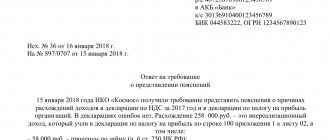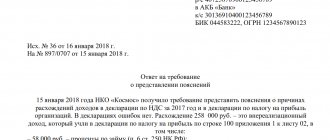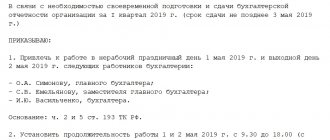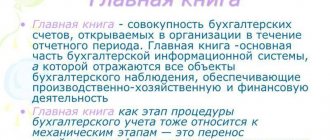After submitting the VAT return for the first quarter of 2022, taxpayers will have to respond to the requirements of the tax authorities regarding the reports already submitted. How to do this will be discussed in the article.
Tax authorities send requests for explanations if the following are identified:
- errors in the tax return and (or) contradictions between the information contained in the documents submitted to the tax authority;
- discrepancy between the information provided by the company and the information contained in the documents available to the tax authority and received by it during tax control;
- submission of an updated tax return to reduce the amount of VAT compared to the previously submitted return (clause 3 of Article 88 of the Tax Code of the Russian Federation).
TAX AUDIT
Important!
At the same time, tax authorities have the right to fine a company only for failure to provide those explanations, the requirement for which was sent on the basis of clause 3 of Article 88 of the Tax Code of the Russian Federation. For example, if the tax authorities sent a request to provide an explanation of the reasons for the decrease in the amount of VAT payable compared to the previous tax period (quarter), then the company has the right not to respond to it.
Tax officials recommend providing explanations separately for each requirement (even if they are homogeneous and received at the same time) (Letter of the Federal Tax Service of the Russian Federation dated November 7, 2016 No. ED-4-15 / [email protected] ).
In what form should explanations be submitted?
Starting from January 24, 2017, “paper” explanations for taxpayers reporting electronically are considered unsubmitted with all the ensuing consequences (a fine of 5 thousand rubles - clause 1 of Article 129.1 of the Tax Code of the Russian Federation, and in case of repeated violation a fine will be charged in the amount of 20 thousand rubles - clause 2 of article 129.1 of the Tax Code of the Russian Federation).
Thus, if a company is required to submit a VAT return in electronic form, then explanations to the declaration must also be submitted in electronic form in the format approved by Order of the Federal Tax Service of the Russian Federation dated December 16, 2016 No. ММВ-7-15/ [email protected] Also you cannot send a scan of “paper” explanations (Letter of the Federal Tax Service of the Russian Federation dated 02/09/2016 No. ED-4-2/1984).
If a company does not have an obligation to report via the Internet, then it has the right to provide explanations to the tax authorities both electronically and on paper.
CAMERA TAX AUDIT IN A NEW LOOK
Reconciliation of VAT accounting data through 1C: Reconciliation
Reconciliation of VAT accounting data with buyers and suppliers:
- Sales (Purchases) – Settlements with counterparties – Reconciliation of VAT accounting data.
Find out more What is the 1C:Sverka service and how to work with it
If the counterparty is duplicated in the 1C database, the message “An error was detected while loading supplier registers” will appear.
If the counterparty is duplicated (TIN/KPP) in the 1C database, then the message “An error was detected when loading supplier registers” will appear.
How to fix:
- open a letter with a file in email and save it to a new folder;
- Downloaded
tab –
More
(top right) –
Download from file
– select a file previously saved from email; - Click Load registry
.
Perfect option
– checking the
Contractors for duplicates
and deleting them.
Which discrepancies most often require explanation?
One of the cases of requesting documents as part of an ongoing desk audit (clause 8.1 of Article 88 of the Tax Code of the Russian Federation) is the identification in the submitted VAT return of a discrepancy between the information about transactions and the information contained in the declaration of another taxpayer.
Automatic reconciliation of purchase (sales) books online is designed to identify discrepancies in the context of each invoice by conducting a virtual counter-check of the taxpayer and his counterparties.
And tax specialists, using the ASK VAT-2 program, compare invoices in the tax reporting of the seller and the buyer.
Often, inconsistencies arise due to asymmetrically reflected details of counterparties’ invoices. The ASK VAT-2 program is not able to recognize invoices for the same transaction if an extra period, hyphen, space, etc. is inserted. On this basis, requests for taxpayers to provide explanations are automatically generated.
If the company incorrectly provided the details of the counterparty's invoice, then in the explanation it is necessary to provide the correct details with a copy of the invoice attached. This error did not result in tax distortion, and therefore there is no need to submit an updated VAT return (Clause 1, Article 81 of the Tax Code of the Russian Federation).
Inconsistencies may arise due to the incorrect TIN of the counterparty company. The “ASK VAT-2” program matches the buyer’s and seller’s tax identification numbers.
In this case, in the explanation, the tax authorities need to provide the correct TIN of the counterparty and indicate the erroneously reflected TIN. This error also did not result in tax distortion, and therefore there is no need to submit an updated VAT return (clause 1 of Article 81 of the Tax Code of the Russian Federation).
ACCOUNTING SERVICES
Settlements with counterparties
Settlements with counterparties:
- Reports – Standard reports – Analysis of sub-accounts
–
Counterparties
(sub-account Counterparties, Agreements, Documents of settlements with counterparties) => there is no detailed balance for: Accounting accounts (60, 62, 76), - Treaties,
- Documents of settlements with counterparties.
- Sales (Purchases) – Settlements with counterparties – Settlements reconciliation statements
– Settlement accounts => separate statements for buyers of accounts. 62, suppliers of accounts. 60 and other calculations. 76.
And the most common case is the presence of a “tax gap”.
The concept of “tax gap” means that the taxpayer has an invoice reflected in the purchase book, which is not reflected in the tax return (in the section where the sales book data is reflected) of the counterparty. That is, “tax gaps” are transactions for which there are deductions, but VAT has not been paid. Such transactions with “tax gaps” are tracked in the tax authorities’ database. And the more such gaps a company has, the more likely it will be scheduled for an on-site tax audit.
Tax authorities often believe that failure to reflect sales from the seller when claiming a deduction from the buyer indicates the buyer’s connection with. Tax authorities understand a legal entity that does not have actual independence, created without the purpose of conducting business activities, does not submit tax reports, registered at the “mass” registration address (Letter of the Federal Tax Service of the Russian Federation dated February 11, 2010 No. 3-7-07/84) . The Federal Tax Service of the Russian Federation constantly posts on its official website ( ) new schemes with participation (Letter dated August 21, 2015 No. AS-4-2 / [email protected] ).
PLANNED CHANGES IN CONCERNING THE CALCULATION OF INCOME TAX AND THE PROCEDURE FOR APPLICATION OF TAX BENEFITS
Using data from the ASK VAT -2 program, tax officials identify contractors using illegal VAT refund schemes.
For this reason, tax authorities demand an explanation and submit an updated declaration, exclude deductions and pay the arrears.
In practice, the reasons for non-mirror VAT may be different. For example, the seller showed VAT calculated on sales in a different tax period. Therefore, in the explanation to the tax authorities, you need to provide documents related to the transaction and attach invoices issued by the seller. In this situation, there is no need to submit an updated VAT return (Clause 1, Article 81 of the Tax Code of the Russian Federation).
But even if the counterparty is, the company cannot be held responsible for the actions of third parties that are beyond its control and influence (Resolution of the North Caucasus District Administration of January 13, 2016 No. F08-9657/15). Thus, the use by tax authorities only of information from the ASK VAT-2 software package without providing adequate evidence of the taxpayer’s dishonesty is not a basis for denying the company the claimed tax deductions.
PROJECTS ON THE INTRODUCTION OF NEW TAXES (FEES)
Important!
Tax authorities check why the taxpayer chose this counterparty based on the criteria given in the Letter of the Russian Federation dated March 23, 2017 No. ED-5-9/ [email protected] For example, tax authorities do not have the right to deprive VAT deductions only on the basis of interrogation of the nominee director and examination of handwriting (Determination of the RF Armed Forces dated 02/06/2017 No. 305-KG16-14921).
In practice, often the cause of inconsistencies is the reflection of invoices for the transaction by the seller and buyer in different tax periods (quarters). For example, the seller reflected an invoice for sales in the first quarter of 2022, and the buyer declared a deduction in the second quarter of 2022. An updated VAT return does not need to be submitted (clause 1 of Article 81 of the Tax Code of the Russian Federation).
DIFFERENCE OF EXITING FROM CAMERA TAX INSPECTION
Complex VAT gaps
In a standard situation, the actors are two taxpayers - the supplier and the buyer, cooperating without intermediaries. If a transaction was completed with the participation of more than two business entities, and discrepancies regarding VAT were identified at one of the stages, this will be considered a complex gap. In this case, tax authorities build a chain of events between counterparties and compile a list of persons involved in the transaction. Tax control measures are carried out on all participants in the chain (for example, requesting documents). At the next stage, Federal Tax Service specialists determine what scheme the counterparties used, at what stage the error appeared, and who is the beneficiary in this transaction.
An approximate diagram of the formation of a tax gap:
- a fly-by-night company sells goods to a transit company, but does not report or pay taxes on this transaction;
- the transit company resells this product to the final buyer (or the next transit participant), pays the tax, reflects the deduction, everything is done correctly in tax accounting;
- the buyer declares the amount of VAT on the transaction with the transitor to be deducted;
- Discrepancies have arisen between the transit company and the fly-by-night company, tax officials are sending requests for information to all participants in the chain.
A one-day company can, before completing a desk audit of the buyer’s declaration, submit reports (without paying tax) and reflect the required transaction in it, thus closing the discrepancies. Then the only option for the Federal Tax Service to prove the illegality of the actions of one or more parties to the transaction will be to order an on-site inspection.
Risk-based approach of tax authorities when conducting desk audits
When conducting desk tax audits, tax officials must take into account the level of tax risk assigned by the ASK VAT-2 risk management system, as well as the result of previous desk tax audits of VAT tax returns (Letter of the Federal Tax Service of the Russian Federation dated January 26, 2017 No. ED-4-15 / [email protected] ). In this Letter, tax officials have proposed an algorithm for determining the volume of documents required from a taxpayer when conducting a desk tax audit of a VAT return.
When conducting desk tax audits, tax authorities must take into account a combination of the following factors:
- the level of tax risk assigned by the Risk Management System of JSC NDS-2;
- the result of previous desk tax audits of VAT tax returns on the issue of the legality of taxpayers using tax benefits (Letter of the Federal Tax Service of the Russian Federation dated January 26, 2017 No. ED-4-15 / [email protected] ).
Sending a response to the Federal Tax Service
Sending a response to the Federal Tax Service from 1C:
- Reports – 1C-Reporting – Regulated reports – VAT declaration (clarified) – Upload – Check – Send
- Inbox – Request – Reply – Insert reply text – Add (primary scans and explanations) – Send
See also:
- Federal Tax Service about errors in the VAT return
- Codes for types of VAT transactions
- Desk audit of VAT declaration
- The period of a desk audit for VAT will be reduced to 2 months
- Updated VAT return: submission procedure
- Cheat sheet for calculating and accounting for penalties
- Calculation and payment of VAT penalties
- Payment of VAT
Did the article help?
Get another secret bonus and full access to the BukhExpert8 help system for 14 days free of charge
Related publications
- Request from the Federal Tax Service for a simplified invoice...
- A universal report to respond to the requirement of the Federal Tax Service, which UTD used to ship goods from a specific customs declaration. We tell you how to set up a Universal report in the 1C: Accounting 8.3 program for...
- How to respond to the request of the Federal Tax Service, the expenses of the declaration according to the simplified tax system do not correspond to the bank statement...
- Revaluation of currency balances and settlements with counterparties...
Explanations on preferential transactions
The taxpayer being audited is required to provide the tax authority with explanations of the transactions (for each transaction code) for which tax benefits are applied. The taxpayer has the right to submit Explanations in the form of a register of supporting documents (hereinafter referred to as the Register), as well as a list and forms of standard agreements used by the taxpayer when carrying out transactions under the relevant codes.
Based on the information contained in the Register submitted by the taxpayer, the tax authority will request documents confirming the validity of the application of tax benefits (Article 93 of the Tax Code of the Russian Federation).
The volume of documents to be requested is determined for each transaction code in accordance with the algorithm set out in Appendix No. 2 to the letter from the tax authorities. The number of documents required depends on the level of tax risk assigned to the taxpayer according to the RMS ASK “VAT-2”. Taxpayers are not required to complete the above Register.
However, if the company does not submit the Register in the recommended form, then the tax authorities will not be able to implement the algorithm proposed in the letter of the Federal Tax Service of the Russian Federation. This means that if the taxpayer fails to submit the Register or if the Register is not submitted in the recommended form, the documents will be requested without using a risk-based approach (i.e. in a continuous manner). Therefore, companies that have repeatedly submitted “preferential” documents during desk tax audits and have a low level of tax risk, it makes sense to prepare a Register recommended by tax authorities. Indeed, in this case, when conducting a desk audit, fewer documents will need to be submitted to the tax office.
RIGHT TO PROPERTY DEDUCTION: ENTREPRENEUR SELLS PROPERTY USED IN BUSINESS
Conclusion
The VAT gap is the deviation between the amount of tax deductible from the buyer and the accrued VAT from the supplier. The reason for the gap may be either technical errors or failure by the supplier to fulfill its obligations to pay VAT.
In general, the buyer is not responsible for paying VAT from its suppliers. Tax authorities can file claims against the buyer only if they prove that this is a scheme aimed at tax evasion.
To justify the right to deduct VAT, a businessman must prove the reality of the transaction and confirm that he checked the supplier before concluding the contract.
How to defer clarification
The taxpayer has five working days to submit clarifications or an updated declaration upon request. Unlike the requirements for the provision of documents, there is no delay in providing explanations (clause 3 of Article 93, clause 5 of Article 93.1 of the Tax Code of the Russian Federation, order of the Federal Tax Service of the Russian Federation dated January 25, 2017 No. ММВ-7-2 / [email protected ] ).
However, companies can generally legally extend the time limit for providing clarification of a claim. Let us remind you that the company must send the receipt of the tax authorities’ request to the tax office within six working days. And the five-day period for giving explanations begins to be calculated from the date of sending the receipt to the tax office about receipt of the requirements.
Important!
Taxpayers have the opportunity to review the contents of the request before sending the receipt. Therefore, knowing about the large volume of requested clarifications, it is advisable for companies to send a receipt of receipt of the request on the last (sixth) working day, thereby extending the period for providing clarifications. COURT PRACTICE ON THE USE OF DATA FROM THE SOFTWARE COMPLEX "ASK NDS-2"
Who can they come to?
At the beginning of the article, it was mentioned about the increased efficiency of desk audits from the point of view of additional VAT assessment. However, in reality, it is very difficult to prove such serious violations of the law, such as the use of various schemes for the purpose of obtaining unjustified tax benefits, within the framework of the chamber. Therefore, materials from desk audits, as a rule, become a reason to go to negligent taxpayers for an on-site audit. Who will the tax inspectors knock on first?
Today there is a lot of talk about the risk-based approach, which forms the basis of tax control. In terms of VAT, this is expressed in the so-called tax traffic light , which inspectors see in their programs. Taxpayers are marked in different colors depending on their level of risk of violating tax laws.
As you might guess, red is a bad color. It is assigned to those companies whose activities raise serious suspicions. They do not pay taxes, do not report, have no employees, no office, and so on. In general, they show the classic signs of fly-by-night companies. Green organizations are conscientious taxpayers who do not arouse any suspicion from the tax authorities. They do everything on time, including resolving emerging issues, for example, submitting clarifications on VAT. Organizations to which the tax authorities may have questions regarding individual transactions are marked in yellow. For example, among the counterparties of such a company is one of the other “yellow” or “red”.
It would seem that companies that are colored red have the greatest risk of on-site inspection. Of course, they are also checked, but the tax authorities pay the main attention to their counterparties and affiliated organizations. They are usually classified as yellow, but can also be green. After all, the one-day items themselves are not of particular interest, since usually there is nothing to take from them. But they are intermediaries in illegal tax schemes, and by unwinding their relationships, you can reach the final beneficiary. But he will already get his in full!










